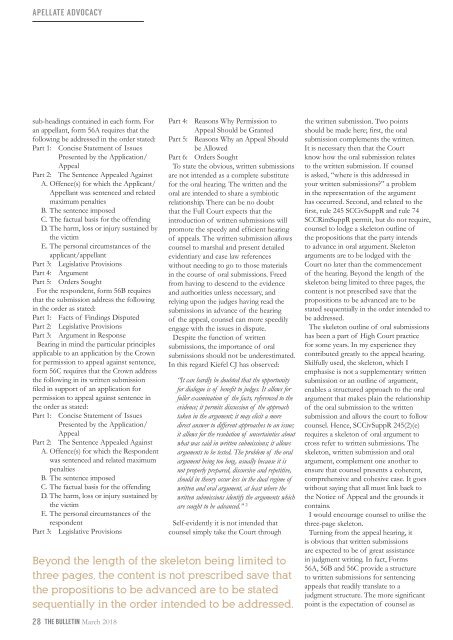LSB March 2018_Web
You also want an ePaper? Increase the reach of your titles
YUMPU automatically turns print PDFs into web optimized ePapers that Google loves.
APELLATE ADVOCACY<br />
sub-headings contained in each form. For<br />
an appellant, form 56A requires that the<br />
following be addressed in the order stated:<br />
Part 1: Concise Statement of Issues<br />
Presented by the Application/<br />
Appeal<br />
Part 2: The Sentence Appealed Against<br />
A. Offence(s) for which the Applicant/<br />
Appellant was sentenced and related<br />
maximum penalties<br />
B. The sentence imposed<br />
C. The factual basis for the offending<br />
D. The harm, loss or injury sustained by<br />
the victim<br />
E. The personal circumstances of the<br />
applicant/appellant<br />
Part 3: Legislative Provisions<br />
Part 4: Argument<br />
Part 5: Orders Sought<br />
For the respondent, form 56B requires<br />
that the submission address the following<br />
in the order as stated:<br />
Part 1: Facts of Findings Disputed<br />
Part 2: Legislative Provisions<br />
Part 3: Argument in Response<br />
Bearing in mind the particular principles<br />
applicable to an application by the Crown<br />
for permission to appeal against sentence,<br />
form 56C requires that the Crown address<br />
the following in its written submission<br />
filed in support of an application for<br />
permission to appeal against sentence in<br />
the order as stated:<br />
Part 1: Concise Statement of Issues<br />
Presented by the Application/<br />
Appeal<br />
Part 2: The Sentence Appealed Against<br />
A. Offence(s) for which the Respondent<br />
was sentenced and related maximum<br />
penalties<br />
B. The sentence imposed<br />
C. The factual basis for the offending<br />
D. The harm, loss or injury sustained by<br />
the victim<br />
E. The personal circumstances of the<br />
respondent<br />
Part 3: Legislative Provisions<br />
28 THE BULLETIN <strong>March</strong> <strong>2018</strong><br />
Part 4: Reasons Why Permission to<br />
Appeal Should be Granted<br />
Part 5: Reasons Why an Appeal Should<br />
be Allowed<br />
Part 6: Orders Sought<br />
To state the obvious, written submissions<br />
are not intended as a complete substitute<br />
for the oral hearing. The written and the<br />
oral are intended to share a symbiotic<br />
relationship. There can be no doubt<br />
that the Full Court expects that the<br />
introduction of written submissions will<br />
promote the speedy and efficient hearing<br />
of appeals. The written submission allows<br />
counsel to marshal and present detailed<br />
evidentiary and case law references<br />
without needing to go to those materials<br />
in the course of oral submissions. Freed<br />
from having to descend to the evidence<br />
and authorities unless necessary, and<br />
relying upon the judges having read the<br />
submissions in advance of the hearing<br />
of the appeal, counsel can more speedily<br />
engage with the issues in dispute.<br />
Despite the function of written<br />
submissions, the importance of oral<br />
submissions should not be underestimated.<br />
In this regard Kiefel CJ has observed:<br />
“It can hardly be doubted that the opportunity<br />
for dialogue is of benefit to judges. It allows for<br />
fuller examination of the facts, referenced to the<br />
evidence; it permits discussion of the approach<br />
taken in the argument; it may elicit a more<br />
direct answer to different approaches to an issue;<br />
it allows for the resolution of uncertainties about<br />
what was said in written submissions; it allows<br />
arguments to be tested. The problem of the oral<br />
argument being too long, usually because it is<br />
not properly prepared, discursive and repetitive,<br />
should in theory occur less in the dual regime of<br />
written and oral argument, at least where the<br />
written submissions identify the arguments which<br />
are sought to be advanced.” 2<br />
Self-evidently it is not intended that<br />
counsel simply take the Court through<br />
Beyond the length of the skeleton being limited to<br />
three pages, the content is not prescribed save that<br />
the propositions to be advanced are to be stated<br />
sequentially in the order intended to be addressed.<br />
the written submission. Two points<br />
should be made here; first, the oral<br />
submission complements the written.<br />
It is necessary then that the Court<br />
know how the oral submission relates<br />
to the written submission. If counsel<br />
is asked, “where is this addressed in<br />
your written submissions?” a problem<br />
in the representation of the argument<br />
has occurred. Second, and related to the<br />
first, rule 245 SCCivSuppR and rule 74<br />
SCCRimSuppR permit, but do not require,<br />
counsel to lodge a skeleton outline of<br />
the propositions that the party intends<br />
to advance in oral argument. Skeleton<br />
arguments are to be lodged with the<br />
Court no later than the commencement<br />
of the hearing. Beyond the length of the<br />
skeleton being limited to three pages, the<br />
content is not prescribed save that the<br />
propositions to be advanced are to be<br />
stated sequentially in the order intended to<br />
be addressed.<br />
The skeleton outline of oral submissions<br />
has been a part of High Court practice<br />
for some years. In my experience they<br />
contributed greatly to the appeal hearing.<br />
Skilfully used, the skeleton, which I<br />
emphasise is not a supplementary written<br />
submission or an outline of argument,<br />
enables a structured approach to the oral<br />
argument that makes plain the relationship<br />
of the oral submission to the written<br />
submission and allows the court to follow<br />
counsel. Hence, SCCivSuppR 245(2)(e)<br />
requires a skeleton of oral argument to<br />
cross refer to written submissions. The<br />
skeleton, written submission and oral<br />
argument, complement one another to<br />
ensure that counsel presents a coherent,<br />
comprehensive and cohesive case. It goes<br />
without saying that all must link back to<br />
the Notice of Appeal and the grounds it<br />
contains.<br />
I would encourage counsel to utilise the<br />
three-page skeleton.<br />
Turning from the appeal hearing, it<br />
is obvious that written submissions<br />
are expected to be of great assistance<br />
in judgment writing. In fact, Forms<br />
56A, 56B and 56C provide a structure<br />
to written submissions for sentencing<br />
appeals that readily translate to a<br />
judgment structure. The more significant<br />
point is the expectation of counsel as


















